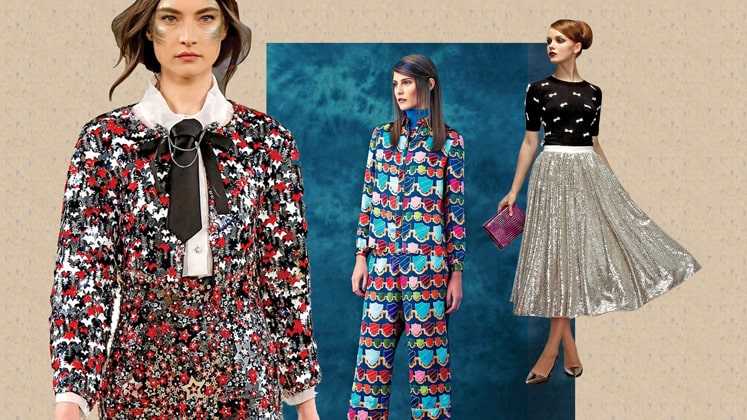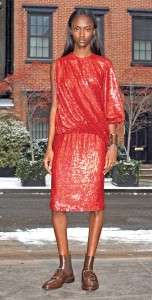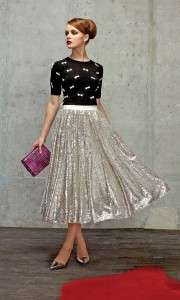
Graduating from a clean and formal winter to minimal varieties of winter looks in the past, the next fall is far away from ‘simple’ as the recent pre-fall catwalks projected a heavy, ultra cozy and highly embellished winter. Even the ongoing menswear runways for autumn/winter 14-15 have displayed value addition in abundance be it through textures or through a creative use of fabrics itself. Following a similar trend in the ongoing production with exporters and manufacturers at the moment, a variety of embroidery techniques, be it hand or computerized, are the most popular on demand globally, along with a lot of prints, and diversity in fabrics. High on “value” as confirmed by the industry, the fashion team at Apparel Online talks to a few players about what is in production for the season…
Glitz and glamour being one of the most directed themes of the year, heavily embellished ensembles with all over shine sequins were a common feature at the runways of designers like Alice + Olivia in the form of an all over sequin fabric skirt, Dennis Basso in tops and dresses, and Givenchy, yet again in a complete sequin fabric dress. Hitting it right on the trend, Mitesh Bhatia of Vamani Overseas said, “For the A/W season, we are creating a wide range of sequined and hand embroidered dresses, skirts, shirts and trousers. The garments we are doing are very jazzy and blingy, therefore a lot of sequins and beads are being used, on styles created in polyesters, light and heavy and viscose rayon”. Working majorly with the black colour, Mitesh is also of the belief that, “A major hit is also digital printing, using which we are creating a lot of innovative and unique graphic prints”.

While some companies are working with embellishments throughout the garment base, there are also players like Goyal Fashions who are embellishing only certain parts of the product. Pankaj Rastogi, Head Design and Development of the company shared, “We are doing only rayon based fabrics for fall-winters right now. We are majorly producing quarter-sleeve and full-sleeve blouses and tunics with a small quantity of zippered bomber jackets. Computerized embroidery and handwork like beadwork and sequins are used as value additions, only for highlighting few parts on the garments. The embroidery and beadwork is not being used to cover the entire surface but to highlight places like, cuffs, collars, neckline, sleeve-hems, waistbands, back yoke etc.”
Be it a line of casuals or semi formals for the day, or for the evening, specifically emerging out of the pre-fall, women runways were embellished gowns and dresses for parties for formal night functions, bringing out a refined and rich red carpet look in each ensemble. Following the same trend, Arjun Sehgal, Owner, of Mariko said, “For A/W, we are doing an evening line, comprising of cocktail dresses, tunics and tops being made out of glass nylon. We are doing couple of jackets in heavy embroidery and sequin embroidery also. Our main focus remains on value addition of garments, and we emphasize more on embroidery and beading. We are also preparing one pleated range of shirts, dresses and tunics, where we have got the base polyester fabric plated by heat-setting”.

While solid colours took a back seat on the runways, what emerged in abundance were prints of each and every type and style, depending upon the designer. While some names like Nonoo, M Missoni and Hervé Léger By Max Azria used graphical digital prints in complex abstract patterns, other like House of Holland and Sass & Bide showcased geometric repeats along with designers like Honor and Preen presenting floral prints. Being explored on a variety of fabric types, the key to the season undoubtedly lies also in printing for added value to a basic garment, reaffirming which, Animesh Saxena of Neetee Clothing added, “We are using all winter-like fabrics such as cotton velvets, wool, flannel, corduroy, denim, which are further improved with value addition of graphic prints and a little bit of embroidery.
The UK/European market is always keen on ordering some high value added garments, and high fashion styles, and we are making quilted jackets, flannel shirts, trousers in neutral colours like blacks, browns and shades of grey”.
Sawhney Export House, one more important player of the value added winter added, “No client is ordering basic garments anymore, and value additions such as embroidery and prints are the most popular techniques for fall.
Following this, most of our styles have graphic digital prints or panel prints with embroidery as value addition,” shared Kamal Manchanda of the company, who are not doing any sort of jackets or high-fashion garments, but still are adding value of all their product ranges as per buyer demands.
Mostly done on silhouettes like tops, skirts, nightwear, and trousers in heavy cotton, wools, corduroy, acrylic, polyester, viscose and silk fabrics, the company is also playing with a myriad of colours in deep winter shades, elaborating on which Kamal added.
“The colours being used in our collections are black, all shades of grey, beige, brown, plum, burgundy, we are also using a lot of natural soft colours (pastels), and shades of sand, mushroom and olives”.
Not experimenting much with the silhouette, what is clear is that the winter season will not go experimental with the styles of garments, but will offer something new and extra in terms of how a designer will treat the other elements of product development of each style. In line with this thought, Muthukumar of Texture Clothing Company said, “We are doing only hoodies, tops and pullovers for the winter developments and only these are the products we are doing regularly and for this season as well, with no new silhouette. But now what is different this winter is the fact that there is mélange and grindle as value additions which are mostly in fashion, and then comes heavy embroidery and high density prints which are also doing well for us”.
The most prominent colours in the company’s collection are black and red, and then teal, purple, grey mélange and charcoal mélange which are also in demand. Adding a bit onto the in demand fabric types, Muthukumar also said, “The main fabric is 8% elastane fabric with more stretch. Then we are using low gauge fleece, interlocks, 100% viscose rayon, viscose elastane, cotton elastane, poly cotton”.

Post a Comment